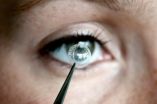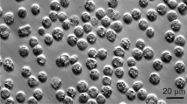(Press-News.org) The study in question has been carried out by a group of researchers at the Department of Biology at Lund University. The research team is specifically focusing on predictions regarding how our water resources will be like in the future, in terms of drinking water, recreation, fishing and biodiversity. They have now published findings on the impact of a warmer climate on lakes in the journal Nature Climate Change.
"The most interesting and unexpected result from the study is that the reaction to climate change will vary between lakes; this has been observed previously but has puzzled researchers. We have shown that the variation is dependent on what organisms are dominant in the lake", says Lars-Anders Hansson, Professor of Aquatic Ecology at Lund University.
In lakes without fish, a warmer climate will lead to clear water without algal blooms. However, the results will be different in lakes containing fish. There, the warmer climate will benefit the fish, which will eat up large quantities of crustaceans (zooplankton). These crustaceans keep the algae in check. When the number of crustaceans falls, the algae will be free to multiply, and algal blooms will increase.
"Since most lakes close to humans contain fish and are also already eutrophicated, we can expect to have to deal with algal blooms even more in the future", says Lars-Anders Hansson.
Conditions will be particularly favourable for the development of blue-green algae, and this is an even greater cause for concern, in the view of Lars-Anders Hansson. Blue-green algae, also known as cyanobacteria, are the type of algae that cause the most problems in lakes and oceans because they form very strong and often toxic algal blooms.
The researchers already know that climate change is expected to lead to a rise in temperatures of 2o C within the lifetime of the coming generation. An increase in leaching of humus-rich water from land and forests is also expected, which will at least double the brownness of the lake water.
"We know that we are going to see a change in the climate, but we are also seeing other major environmental changes taking place, for example 'brownification'. This means that we have several simultaneous changes that will interact and possibly create synergies", says Lars-Anders Hansson.
In the Future Water research project, a large experiment has been set up based on these conditions, in order to study what impact they may have on organisms and water quality in the future.
### END
Lakes react differently to warmer climate
2012-10-04
ELSE PRESS RELEASES FROM THIS DATE:
Artificial cornea gives the gift of vision
2012-10-04
Our eyes are our window to the world. Thousands of people have lost their eyesight due to damages to the cornea, such as trauma, absent limbal stem cells or diseases. Transplantation of a donor cornea is the therapy of choice for a great number of those patients. Let alone the issue of scarce donor material, a sub-group of patients do not tolerate transplanted corneas, necessitating the employment of an alternative means of restoring eye sight. In Germany alone, around 7,000 patients are waiting to be treated. In close cooperation with the Aachen Centre of Technology ...
Researchers a step closer to controlling inflammation in MS
2012-10-04
A University of Adelaide researcher has published results that suggest a possible new mechanism to control multiple sclerosis (MS).
Dr Iain Comerford from the University's School of Molecular and Biomedical Science earned a three-year fellowship from MS Research Australia to work on this project. It is directed towards understanding how specific enzymes in cells of the immune system regulate immune cell activation and migration.
Along with his colleagues, Professor Shaun McColl and PhD students Wendel Litchfield and Ervin Kara, he focused on a molecule known as PI3Kgamma, ...
More certainty on uncertainty's quantum mechanical role
2012-10-04
WASHINGTON, Oct. 4—Scientists who study the ultra-small world of atoms know it is impossible to make certain simultaneous measurements, for example finding out both the location and momentum of an electron, with an arbitrarily high level of precision. Because measurements disturb the system, increased certainty in the first measurement leads to increased uncertainty in the second. The mathematics of this unintuitive concept – a hallmark of quantum mechanics – were first formulated by the famous physicist Werner Heisenberg at the beginning of the 20th century and became ...
VIMS researchers unravel life cycle of blue-crab parasite
2012-10-04
Professor Jeff Shields and colleagues at the Virginia Institute of Marine Science have succeeded in their 15-year effort to unravel the life history of Hematodinium, a single-celled parasite that afflicts blue crabs and is of growing concern to aquaculture operations and wild fisheries around the world.
Knowledge of the parasite's complex life cycle—gained by rearing of successive generations across a full year in a VIMS laboratory—will help guide efforts to understand the transmission of Hematodinium within crab populations and shrimp farms, and to develop best practices ...
Fox squirrels show long-term investment savvy when hoarding nuts
2012-10-04
Researchers at the University of California, Berkeley, are gathering evidence this fall that the feisty fox squirrels scampering around campus are not just mindlessly foraging for food, but engaging in a long-term savings strategy. Humans could learn something about padding their nest eggs from squirrels' diversification efforts.
Of course, with squirrels, it's not about money, but about nuts.
"Think of them as little bankers depositing money and spreading it out in different funds, and doing some management of those funds," said Mikel Delgado, a doctoral student ...
Nonprescription medication abuse underestimated
2012-10-04
Nonprescription medications are just as likely a cause of poisoning as prescription drugs, according to a new study by Timothy Wiegand, M.D. from the University of Rochester Medical Center in the US and colleagues. Their work, which analyzes the data from the second annual report of the Toxicology Investigators Consortium (ToxIC), is published online in Springer's Journal of Medical Toxicology.
In 2010, the American College of Medical Toxicology established its case registry, ToxIC, which acts as a real-time surveillance system to identify current poisoning trends, and ...
Study reveals how bicultural consumers respond to marketing cues
2012-10-04
NEW YORK - October 4, 2012 - Consider a Japanese-American woman strolling through a mall. If she passes by a UNIQLO store, is she more likely to opt for sushi than a hamburger when she reaches the food court? Would this cue of Japanese culture draw out her Japanese side? The answer, according to new research from Columbia Business School's Michael Morris, the Chavkin-Chang Professor of Leadership, and Aurelia Mok, Assistant Professor, City University of Hong Kong (she received her Ph.D. from Columbia Business School in 2010), depends on the degree to which she has integrated ...
A molecular scissor related to Alzheimer's disease
2012-10-04
This press release is available in Spanish.An international research team led by the Spanish National Research Council (CSIC) and researchers from Kiel University revealed the atomic‐level structure of the human peptidase enzyme meprin β (beta). The study was published online in the journal Proceedings of the National Academy of Sciences.
"Now that we know how meprin β looks, how it works and how it relates to diseases, we can search for substances that stop its enzyme activities when they become harmful", explains Xavier Gomis‐Rüth, researcher at ...
NYU researchers find electricity in biological clock
2012-10-04
Biologists from New York University have uncovered new ways our biological clock's neurons use electrical activity to help keep behavioral rhythms in order. The findings, which appear in the journal Current Biology, also point to fresh directions for exploring sleep disorders and related afflictions.
"This process helps explain how our biological clocks keep such amazingly good time," said Justin Blau, an associate professor of biology at NYU and one of the study's authors.
Blau added that the findings may offer new pathways for exploring treatments to sleep disorders ...
Shoulder dislocation in older patients poses different challenges in diagnosis, treatment
2012-10-04
ROSEMONT, Ill.—Although shoulder dislocation can occur at about the same rates in both younger and older patients, injuries in older patients are more likely to be overlooked or misdiagnosed, resulting in years of persistent pain and disability. A new study published in the October 2012 issue of the Journal of the American Academy of Orthopaedic Surgeons examines the differences in dislocation injuries between older and younger patients and suggests an approach to evaluate older patients that could help improve diagnosis and management of interrelated injuries.
Study ...



